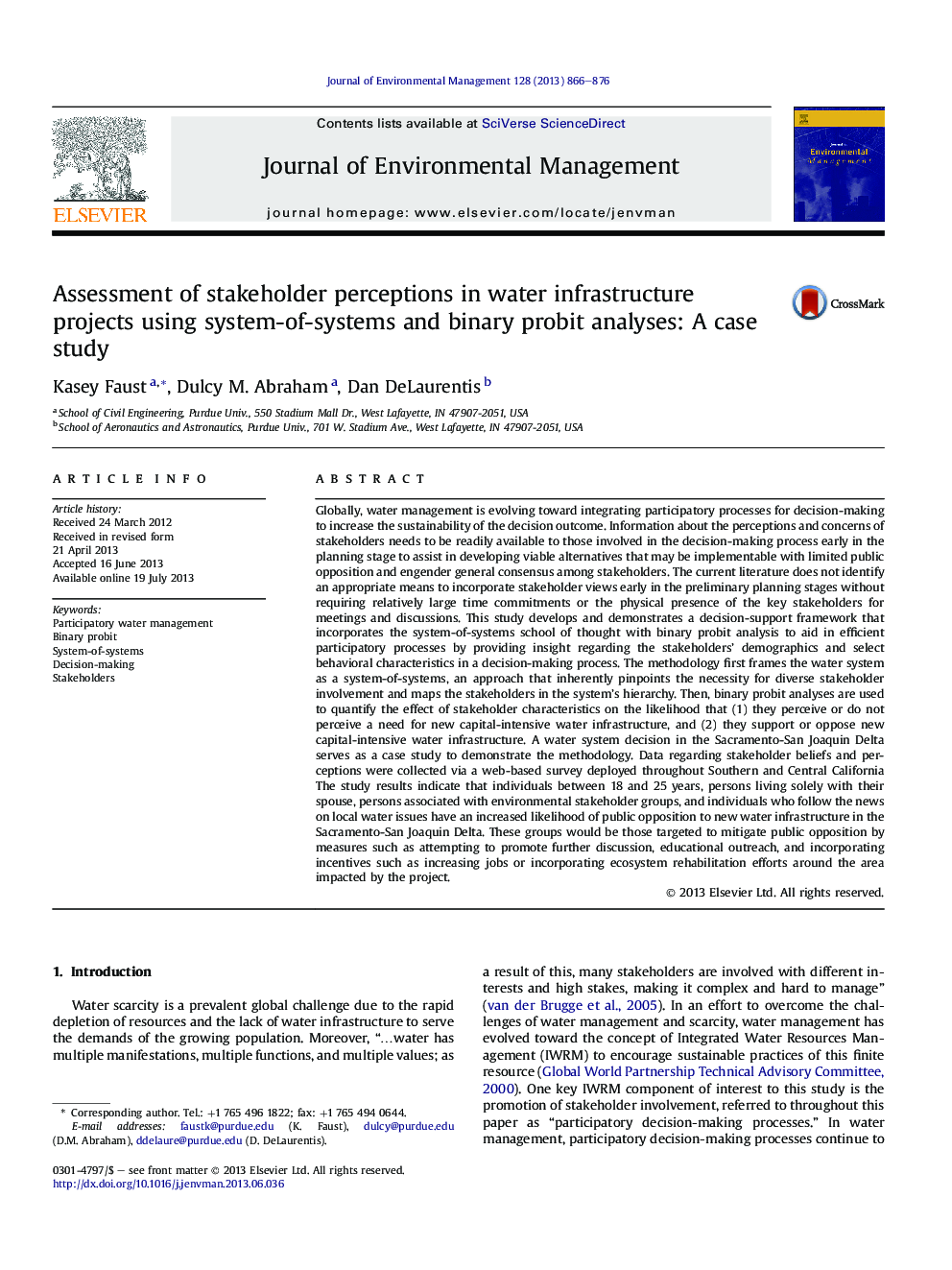| کد مقاله | کد نشریه | سال انتشار | مقاله انگلیسی | نسخه تمام متن |
|---|---|---|---|---|
| 7484594 | 1485284 | 2013 | 11 صفحه PDF | دانلود رایگان |
عنوان انگلیسی مقاله ISI
Assessment of stakeholder perceptions in water infrastructure projects using system-of-systems and binary probit analyses: A case study
ترجمه فارسی عنوان
ارزیابی نظرات ذینفعان در پروژه های زیربنایی آب با استفاده از سیستم های سیستم و تجزیه و تحلیل پروبیوتی دودویی: مطالعه موردی
دانلود مقاله + سفارش ترجمه
دانلود مقاله ISI انگلیسی
رایگان برای ایرانیان
کلمات کلیدی
مدیریت آب مشارکتی، پروبیت دوتایی، سیستم های سیستم، تصمیم سازی، سهامداران،
ترجمه چکیده
در سطح جهانی، مدیریت آب به سوی ادغام فرایندهای مشارکتی برای تصمیم گیری برای افزایش پایداری تصمیمات در حال تحول است. اطلاعات مربوط به درک و نگرانی سهامداران باید برای افرادی که در فرایند تصمیم گیری در اوایل مرحله برنامه ریزی حضور دارند، به آسانی در دسترس باشند تا بتوانند در ایجاد گزینه های مناسب که ممکن است با مخالفت های عمومی به اجرا در می آیند و منافع عمومی را در میان سهامداران به وجود آورد. ادبیات در حال حاضر ابزار مناسب برای ترکیب دیدگاه های ذینفعان در اوایل مراحل برنامه ریزی اولیه نیست، بدون نیاز به تعهدات نسبتا بزرگ و یا حضور فیزیکی ذینفعان اصلی برای جلسات و بحث ها. این مطالعه یک چارچوب حمایت از تصمیم گیری را نشان می دهد که مکتب سیستم های سیستم را با تجزیه و تحلیل پروبیوتی دودویی به منظور کمک به فرایندهای مشارکتی کارآمد با ارائه بینش در مورد جمعیت شناسی ذینفعان و ویژگی های رفتاری در فرآیند تصمیم گیری، نشان می دهد. این روش ابتدا سیستم آب را به عنوان یک سیستم سیستم، یک رویکرد که به طور ذاتی ضروری برای مشارکت متقابل ذینفعان را تشریح می کند و ذینفعان را در سلسله مراتب سیستم می نویسد، را مد نظر قرار می دهد. سپس، تجزیه و تحلیل پروبیت های دوتایی برای اندازه گیری اثر مشخصات ذینفعان در مورد احتمال (1) آنها درک یا نیاز به زیرساخت های جدید سرمایه با سرمایه را درک نمی کنند و (2) آنها با حمایت از مخالفت با سرمایه های جدید سرمایه زیر ساخت. تصمیم سیستم آب در دلتا ساکرامنتو سان جویکین به عنوان نمونه موردی برای نشان دادن روش شناسی عمل می کند. داده های مربوط به اعتقادات و ادراکات ذینفع از طریق یک بررسی مبتنی بر وب در کل کالیفرنیا جنوبی و مرکزی جمع آوری شد. نتایج مطالعه نشان می دهد که افراد بین 18 تا 25 سال، افرادی که تنها با همسرشان زندگی می کنند، افراد مرتبط با گروه های ذینفع محیطی و افرادی که دنبال می کنند اخبار مربوط به مسائل مربوط به آب محلی، احتمال افزایش مخالفت عمومی با زیرساخت های جدید آب در دلتا ساکرامنتو سان جویکین را افزایش می دهد. این گروه ها کسانی هستند که برای مقابله با مخالفت عمومی از طریق اقداماتی نظیر تلاش برای ترویج بحث بیشتر، گسترش آموزش و ایجاد انگیزه هایی مانند افزایش مشاغل یا استفاده از تلاش های توانبخشی اکوسیستم در اطراف منطقه تحت تاثیر پروژه، قرار می گیرند.
موضوعات مرتبط
مهندسی و علوم پایه
مهندسی انرژی
انرژی های تجدید پذیر، توسعه پایدار و محیط زیست
چکیده انگلیسی
Globally, water management is evolving toward integrating participatory processes for decision-making to increase the sustainability of the decision outcome. Information about the perceptions and concerns of stakeholders needs to be readily available to those involved in the decision-making process early in the planning stage to assist in developing viable alternatives that may be implementable with limited public opposition and engender general consensus among stakeholders. The current literature does not identify an appropriate means to incorporate stakeholder views early in the preliminary planning stages without requiring relatively large time commitments or the physical presence of the key stakeholders for meetings and discussions. This study develops and demonstrates a decision-support framework that incorporates the system-of-systems school of thought with binary probit analysis to aid in efficient participatory processes by providing insight regarding the stakeholders' demographics and select behavioral characteristics in a decision-making process. The methodology first frames the water system as a system-of-systems, an approach that inherently pinpoints the necessity for diverse stakeholder involvement and maps the stakeholders in the system's hierarchy. Then, binary probit analyses are used to quantify the effect of stakeholder characteristics on the likelihood that (1) they perceive or do not perceive a need for new capital-intensive water infrastructure, and (2) they support or oppose new capital-intensive water infrastructure. A water system decision in the Sacramento-San Joaquin Delta serves as a case study to demonstrate the methodology. Data regarding stakeholder beliefs and perceptions were collected via a web-based survey deployed throughout Southern and Central California The study results indicate that individuals between 18 and 25 years, persons living solely with their spouse, persons associated with environmental stakeholder groups, and individuals who follow the news on local water issues have an increased likelihood of public opposition to new water infrastructure in the Sacramento-San Joaquin Delta. These groups would be those targeted to mitigate public opposition by measures such as attempting to promote further discussion, educational outreach, and incorporating incentives such as increasing jobs or incorporating ecosystem rehabilitation efforts around the area impacted by the project.
ناشر
Database: Elsevier - ScienceDirect (ساینس دایرکت)
Journal: Journal of Environmental Management - Volume 128, 15 October 2013, Pages 866-876
Journal: Journal of Environmental Management - Volume 128, 15 October 2013, Pages 866-876
نویسندگان
Kasey Faust, Dulcy M. Abraham, Dan DeLaurentis,
